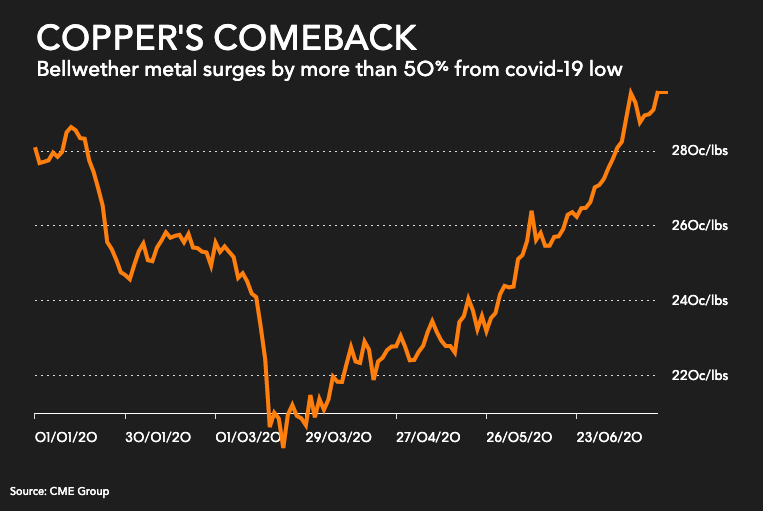Copper futures prices rallied on Tuesday after the agreement of a massive economic stimulus plan in Europe, optimism about a covid-19 vaccine and ongoing worries about pandemic-hit supply from top producer South America.
Copper for delivery in September trading in New York changed hands for $2.9750 a pound ($6,560 a tonne) in early afternoon trade, up 2% from yesterday’s settlement.
Copper futures prices are on track for the highest close in two years and are now up by more than 50% from the covid-19 lows struck in March.
Top listed copper miner BHP on Tuesday announced that it expects its copper output to fall by between 5% and 14% in its next fiscal year to end-June 2021.
BHP, which part owns and operates Escondida in Chile, the world’s largest copper mine, said the expected fall in copper production is due to a reduction in its workforce related to covid-19 restrictions.
The Melbourne-based company now expects 2020-2021 copper output of between 1.48m – 1.65m tonnes, down from 1.72m tonnes produced in the year prior.

In a recent note Capital Economics point out that output rates have fallen sharply in Chile, Peru and Mexico which together account for 45% of global production.
Output is now at levels last seen in 2017 during a protracted strike at Escondida, which by itself is responsible for nearly 5% of worldwide production.
Surging Chinese imports
Customs data released last week showed China’s unwrought copper imports (anodes and cathodes) in June rose a stunning 50% from the previous month to 656,483 tonnes – a full 15% above the previous monthly record.
June cargoes were double that of the same month last year as the infrastructure and manufacturing sectors in China, responsible for more than half the world’s copper consumption, rapidly recover following the covid-19 slump.
Over the first half of 2020, imports totalled 2.84m tonnes – up 25% year-on-year and on track to easily beat 2018’s annual record of 5.3m tonnes.
June imports of copper concentrate fell unexpectedly, down 6% to 1.69m tonnes from May, but still up 8.4% from June last year due to disruption at mines in Peru, China’s top supplier.
Another indication of demand outstripping supply is the decline in treatment and refining charges. TC/RCs paid by miners to smelters have fallen to an eight-year low, a sign of competition between refiners for available concentrate.
For the first six months of 2020 imports total 10.84 million tonnes, on pace to surpass last year’s record-breaking tally of 22 million tonnes.
Hedge fund bulls
Commodity Futures Trading Commission data show hedge fund positioning in the copper market at its most bullish in two years.
Large-scale speculators like hedge funds have built long positions (bets that copper will trade at a higher level in the future) to pre-pandemic levels and at the same time cut shorts (bets that copper can be bought back at a lower price in the future).
As of Tuesday last week the net balance was a collective long position of 41,309 contracts, up nearly 30% from the week before and the strongest expression of bullish sentiment since June 2018.
